

Compact Muon Solenoid
LHC, CERN
| CMS-PAS-B2G-16-022 | ||
| Search for heavy resonances decaying into a Z boson and a W boson in the ℓ+ℓ−qˉq final state | ||
| CMS Collaboration | ||
| January 2017 | ||
| Abstract: A search for heavy resonances decaying into a pair of vector bosons is performed in the 2ℓ2q final state using 12.9 fb−1 of data collected in 2016 by the CMS experiment at the LHC in proton-proton collisions with a center-of-mass energy of √s= 13 TeV. The final state probed involves the leptonic decay of a Z boson (Z→ℓℓ, with ℓ=e,μ), while the other vector boson W is reconstructed from high-momentum quark pairs detected as a single massive jet. The discriminating power of the jet mass distribution and jet substructure are exploited to suppress the amount of background from known standard model processes. The search is performed in the boosted regime for resonances with mass larger than 600 GeV up to 3000 GeV. The result is consistent with the standard model prediction and upper limits on the production cross section for spin-1 resonances are derived as a function of the resonance mass. | ||
| Links: CDS record (PDF) ; inSPIRE record ; CADI line (restricted) ; | ||
| Figures | |

png pdf |
Figure 1:
Transverse momentum of the Z boson candidate (left) and AK8 jet (right) selected in the analysis. Only events with jet mass greater than 30 GeV are shown. The shaded area represents the statistical uncertainty on the simulated samples. The ratio of data over simulation is reported at the bottom of each panel. A W' signal model hypothesis, magnified by a factor 10, is also shown. |
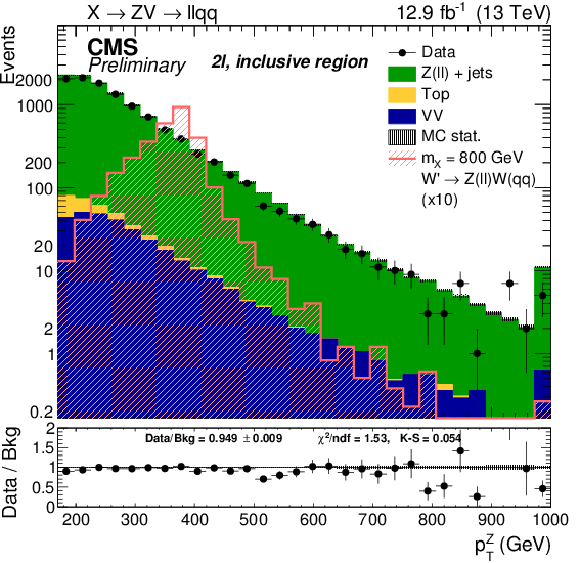
png pdf |
Figure 1-a:
Transverse momentum of the Z boson candidateselected in the analysis. Only events with jet mass greater than 30 GeV are shown. The shaded area represents the statistical uncertainty on the simulated samples. The ratio of data over simulation is reported at the bottom of each panel. A W' signal model hypothesis, magnified by a factor 10, is also shown. |

png pdf |
Figure 1-b:
Transverse momentum of AK8 jet selected in the analysis. Only events with jet mass greater than 30 GeV are shown. The shaded area represents the statistical uncertainty on the simulated samples. The ratio of data over simulation is reported at the bottom of each panel. A W' signal model hypothesis, magnified by a factor 10, is also shown. |
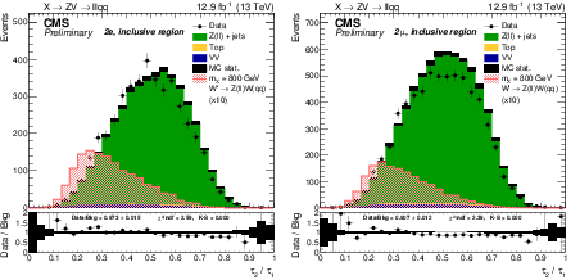
png pdf |
Figure 2:
The τ21 of the AK8 jet selected in the electron (left) and muon (right) categories. Only events with jet mass greater than 30 GeV are shown. The shaded area represents the statistical uncertainty on the simulated samples. The ratio of data over simulation is reported at the bottom of each panel. A W' signal model hypothesis, magnified by a factor 10, is also shown. |
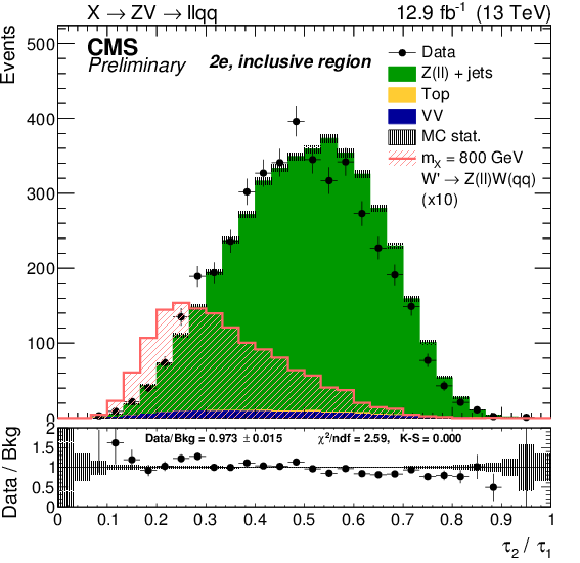
png pdf |
Figure 2-a:
The τ21 of the AK8 jet selected in the electron category. Only events with jet mass greater than 30 GeV are shown. The shaded area represents the statistical uncertainty on the simulated samples. The ratio of data over simulation is reported at the bottom of each panel. A W' signal model hypothesis, magnified by a factor 10, is also shown. |
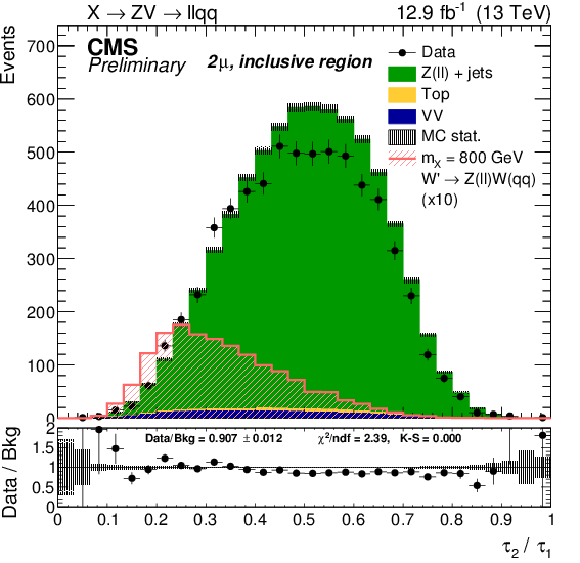
png pdf |
Figure 2-b:
The τ21 of the AK8 jet selected in the muon category. Only events with jet mass greater than 30 GeV are shown. The shaded area represents the statistical uncertainty on the simulated samples. The ratio of data over simulation is reported at the bottom of each panel. A W' signal model hypothesis, magnified by a factor 10, is also shown. |
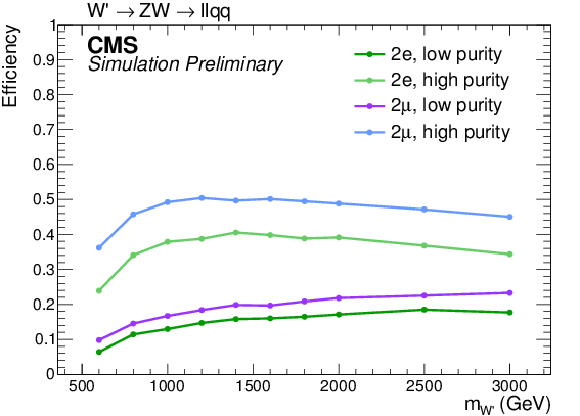
png pdf |
Figure 3:
Signal efficiency for a W' signal model, separated by final state and purity category. The efficiency is evaluated as the fraction of generated signal events decaying in the ℓℓqq final state (with ℓ=e,μ depending on the considered leptonic category) passing the event selections described in Section. |

png pdf |
Figure 4:
Functional forms modeling the mj distributions extracted from a fit to data (Z+jets) or derived from simulation (Top and VV) in the electron (top) and muon (bottom) channels, for the high (left) and low (right) purity categories. The shaded area represents the Z+jets distribution uncertainty. The bottom panels report the pulls distribution between data and SM background expectation (Ndata−Nbkg)/σ, where σ is the normalized Poisson error on the data. |
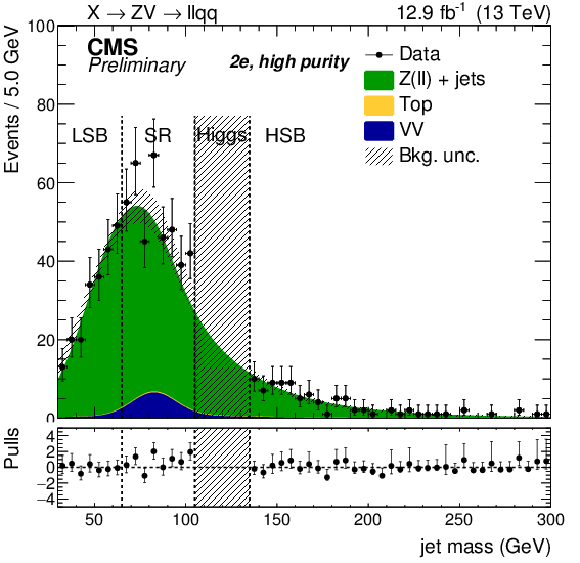
png pdf |
Figure 4-a:
Functional forms modeling the mj distributions extracted from a fit to data (Z+jets) or derived from simulation (Top and VV) in the electron muon channel, for the high purity category. The shaded area represents the Z+jets distribution uncertainty. The bottom panel reports the pulls distribution between data and SM background expectation (Ndata−Nbkg)/σ, where σ is the normalized Poisson error on the data. |

png pdf |
Figure 4-b:
Functional forms modeling the mj distributions extracted from a fit to data (Z+jets) or derived from simulation (Top and VV) in the electron channel, for the low purity category. The shaded area represents the Z+jets distribution uncertainty. The bottom panel reports the pulls distribution between data and SM background expectation (Ndata−Nbkg)/σ, where σ is the normalized Poisson error on the data. |

png pdf |
Figure 4-c:
Functional forms modeling the mj distributions extracted from a fit to data (Z+jets) or derived from simulation (Top and VV) in the muon channel, for the high purity category. The shaded area represents the Z+jets distribution uncertainty. The bottom panel reports the pulls distribution between data and SM background expectation (Ndata−Nbkg)/σ, where σ is the normalized Poisson error on the data. |

png pdf |
Figure 4-d:
Functional forms modeling the mj distributions extracted from a fit to data (Z+jets) or derived from simulation (Top and VV) in the muon channel, for the low purity category. The shaded area represents the Z+jets distribution uncertainty. The bottom panel reports the pulls distribution between data and SM background expectation (Ndata−Nbkg)/σ, where σ is the normalized Poisson error on the data. |

png pdf |
Figure 5:
Expected and observed events on the resonance candidate mass mVZ distributions in the electron (top) and muon (bottom) channels, and separately for the high (left) and low purity (right) categories. The shaded area represents the shape uncertainty on the Z+jets background. The bottom panels report the pulls distribution between data and SM background expectation (Nobs−Nbkg)/σ, where σ is the normalized Poisson error on the data. |

png pdf |
Figure 5-a:
Expected and observed events on the resonance candidate mass mVZ distributions in the electron channel, and separately for the high purity category. The shaded area represents the shape uncertainty on the Z+jets background. The bottom panels report the pulls distribution between data and SM background expectation (Nobs−Nbkg)/σ, where σ is the normalized Poisson error on the data. |
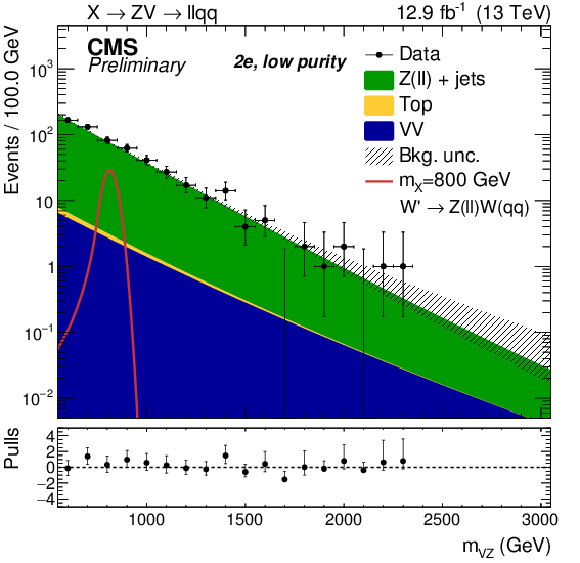
png pdf |
Figure 5-b:
Expected and observed events on the resonance candidate mass mVZ distributions in the electron channel, and separately for the low purity category. The shaded area represents the shape uncertainty on the Z+jets background. The bottom panels report the pulls distribution between data and SM background expectation (Nobs−Nbkg)/σ, where σ is the normalized Poisson error on the data. |
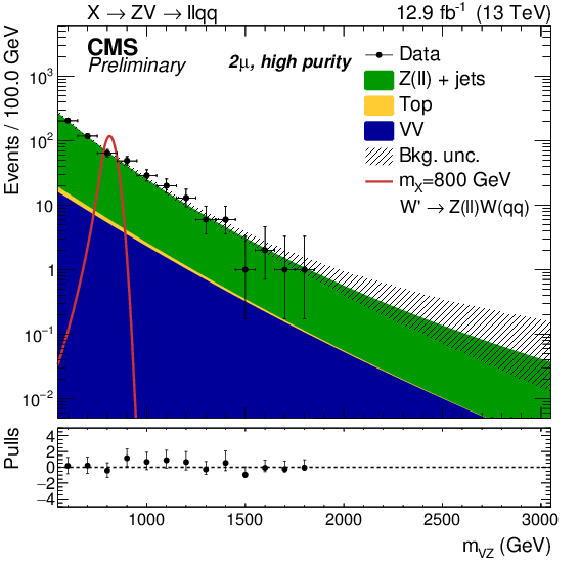
png pdf |
Figure 5-c:
Expected and observed events on the resonance candidate mass mVZ distributions in the muon channel, and separately for the high purity category. The shaded area represents the shape uncertainty on the Z+jets background. The bottom panels report the pulls distribution between data and SM background expectation (Nobs−Nbkg)/σ, where σ is the normalized Poisson error on the data. |
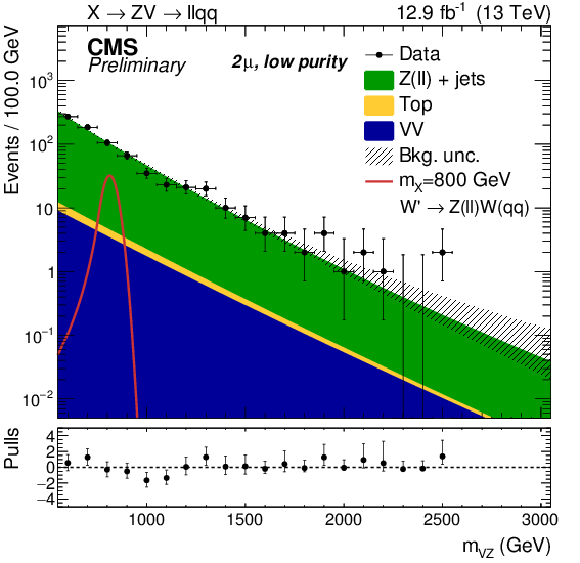
png pdf |
Figure 5-d:
Expected and observed events on the resonance candidate mass mVZ distributions in the muon channel, and separately for the low purity category. The shaded area represents the shape uncertainty on the Z+jets background. The bottom panels report the pulls distribution between data and SM background expectation (Nobs−Nbkg)/σ, where σ is the normalized Poisson error on the data. |
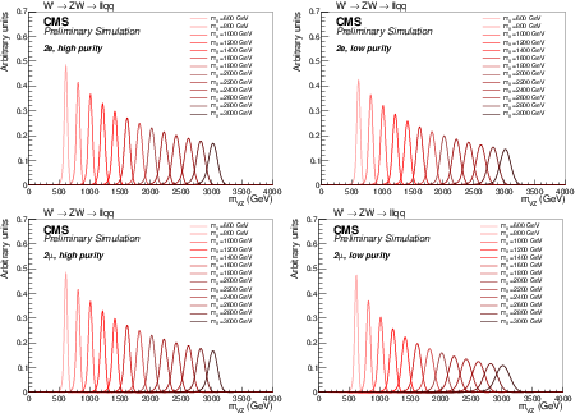
png pdf |
Figure 6:
Reconstructed signal mass mVZ for different generated mass mX hypotheses of a W' signal, modeled with a Crystal Ball function, and separately by final state: electron (top) and muon (bottom) channels, and separately for the high (left) and low purity (right) categories. The distributions are normalized to unit area. |

png pdf |
Figure 6-a:
Reconstructed signal mass mVZ for different generated mass mX hypotheses of a W' signal, modeled with a Crystal Ball function, and separately by final state: electron channel, and separately for the high purity category. The distributions are normalized to unit area. |

png pdf |
Figure 6-b:
Reconstructed signal mass mVZ for different generated mass mX hypotheses of a W' signal, modeled with a Crystal Ball function, and separately by final state: electron channel, and separately for the low purity category. The distributions are normalized to unit area. |

png pdf |
Figure 6-c:
Reconstructed signal mass mVZ for different generated mass mX hypotheses of a W' signal, modeled with a Crystal Ball function, and separately by final state: muon channel, and separately for the high purity category. The distributions are normalized to unit area. |

png pdf |
Figure 6-d:
Reconstructed signal mass mVZ for different generated mass mX hypotheses of a W' signal, modeled with a Crystal Ball function, and separately by final state: muon channel, and separately for the low purity category. The distributions are normalized to unit area. |
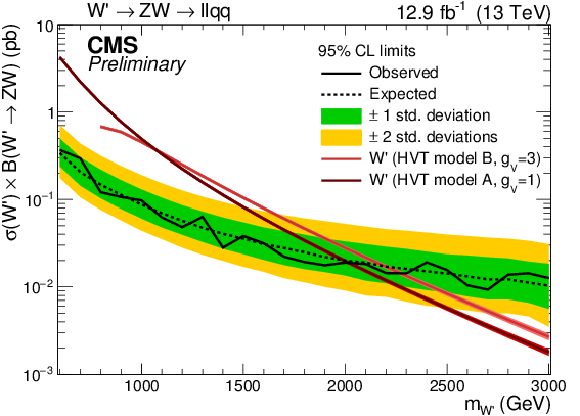
png pdf |
Figure 7:
Observed and expected 95% CL upper limit on σW′×B(W′→ZW) as a function of the resonance mass for a narrow spin-1 resonance , including all statistical and systematic uncertainties. The electron and muon channels and high and low purity categories are combined together. The green and yellow bands are the ±1 and ±2 standard deviation uncertainty bands on the expected limit. Theoretical predictions for W' produced in the framework of HVT model A and model B are also shown. |
| Tables | |

png pdf |
Table 1:
Expected and observed number of events in the SR (65 <mj< 105 GeV). The uncertainties originating from the fit and the top and diboson mj distributions are reported separately, as well as the difference in normalization between the nominal and the alternative function choice. |
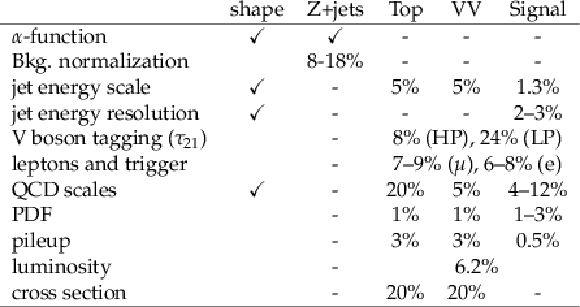
png pdf |
Table 2:
Summary of systematic uncertainties for backgrounds and signal samples. The uncertainty sources propagated to the mVZ shape are marked with a tick. In the case a systematic uncertainty depends in the resonance mass (for signal) or on the category (for background), the extreme values are reported in the table. |
| Summary |
| This article describes a search for a heavy resonance with mass between 600 GeV and 3 TeV, decaying into a Z boson and a W boson. The data collected at √s= 13 TeV during the 2016 operations by the CMS experiment at LHC Run-2 are analyzed. The data set size corresponds to an integrated luminosity of 12.9 fb−1. The final state explored consists in the leptonic decays of the Z boson into an electron or muon pair, and the decay of the W boson into a pair of collimated quarks. Depending on the resonance mass, upper limits of 12-370 fb are set on the cross section of a spin-1 HVT W' signal multiplied by the ZW branching ratio. The results of the present analysis do not confirm the mild excess consistent with a mass hypothesis of 650 GeV observed by the CMS collaboration [56], and are comparable with the most recent results of the ATLAS collaboration [57]. |
| References | ||||
| 1 | ATLAS Collaboration | Observation of a new particle in the search for the Standard Model Higgs boson with the ATLAS detector at the LHC | PLB 716 (2012) 1 | 1207.7214 |
| 2 | CMS Collaboration | Observation of a new boson at a mass of 125 GeV with the CMS experiment at the LHC | PLB 716 (2012) 30 | CMS-HIG-12-028 1207.7235 |
| 3 | CMS Collaboration | Observation of a new boson with mass near 125 GeV in pp collisions at √s= 7 and 8 TeV | JHEP 06 (2013) 081 | CMS-HIG-12-036 1303.4571 |
| 4 | CMS Collaboration | Precise determination of the mass of the Higgs boson and tests of compatibility of its couplings with the standard model predictions using proton collisions at 7 and 8 TeV | EPJC 75 (2015) 212 | CMS-HIG-14-009 1412.8662 |
| 5 | ATLAS Collaboration | Measurement of the Higgs boson mass from the H→γγ and H→ZZ∗→4ℓ channels in pp collisions at center-of-mass energies of 7 and 8 TeV with the ATLAS detector | PRD 90 (2014) 052004 | 1406.3827 |
| 6 | ATLAS Collaboration | Evidence for the spin-0 nature of the Higgs boson using ATLAS data | PLB 726 (2013) 120 | 1307.1432 |
| 7 | CMS and ATLAS Collaborations | Combined Measurement of the Higgs Boson Mass in pp Collisions at √s= 7 and 8 TeV with the ATLAS and CMS Experiments | PRL 114 (2015) 191803 | 1503.07589 |
| 8 | CMS Collaboration | Search for a pseudoscalar boson decaying into a Z boson and the 125 GeV Higgs boson in ℓ+ℓ−b¯b final states | PLB 748 (2015) 221--243 | CMS-HIG-14-011 1504.04710 |
| 9 | CMS Collaboration | Search for a massive resonance decaying into a Higgs boson and a W or Z boson in hadronic final states in proton-proton collisions at √s= 8 TeV | JHEP 02 (2016) 145, , Submitted to JHEP | CMS-EXO-14-009 1506.01443 |
| 10 | CMS Collaboration | Search for Narrow High-Mass Resonances in Proton-Proton Collisions at √s= 8 TeV Decaying to a Z and a Higgs Boson | PLB 748 (2015) 255--277 | CMS-EXO-13-007 1502.04994 |
| 11 | CMS Collaboration | Search for massive WH resonances decaying into the ℓνb¯b final state at √s= 8 TeV | EPJC76 (2016), no. 5, 237 | CMS-EXO-14-010 1601.06431 |
| 12 | CMS Collaboration | Search for massive resonances decaying into pairs of boosted W and Z bosons at √s= 13 TeV | CMS-PAS-EXO-15-002 | CMS-PAS-EXO-15-002 |
| 13 | CMS Collaboration Collaboration | Search for new resonances decaying to WW/WZ→ℓνqq | Technical Report CMS-PAS-B2G-16-020, CERN, Geneva | |
| 14 | CMS Collaboration Collaboration | Search for massive resonances decaying into WW, WZ, ZZ, qW and qZ in the dijet final state at √s= 13 TeV using 2016 data | Technical Report CMS-PAS-B2G-16-021, CERN, Geneva | |
| 15 | CMS Collaboration | Search for heavy resonances decaying into a vector boson and a Higgs boson in the (ℓℓ, ℓν, νν) bb final state | CMS-PAS-B2G-16-003 | CMS-PAS-B2G-16-003 |
| 16 | V. D. Barger, W.-Y. Keung, and E. Ma | A Gauge Model With Light W and Z Bosons | PRD 22 (1980) 727 | |
| 17 | E. Salvioni, G. Villadoro, and F. Zwirner | Minimal Z' models: present bounds and early LHC reach | JHEP 09 (2009) 068 | 0909.1320 |
| 18 | C. Grojean, E. Salvioni, and R. Torre | A weakly constrained W' at the early LHC | JHEP 07 (2011) 002 | 1103.2761 |
| 19 | R. Contino, D. Pappadopulo, D. Marzocca, and R. Rattazzi | On the effect of resonances in composite Higgs phenomenology | JHEP 11 (2011) 1--50 | |
| 20 | D. Marzocca, M. Serone, and J. Shu | General composite Higgs models | JHEP 12 (2012) 1--52 | |
| 21 | B. Bellazzini, C. Csaki, and J. Serra | Composite Higgses | EPJC 74 (2014) 2766 | 1401.2457 |
| 22 | T. Han, H. E. Logan, B. McElrath, and L.-T. Wang | Phenomenology of the little Higgs model | PRD 67 (2003) 095004 | hep-ph/0301040 |
| 23 | M. Schmaltz and D. Tucker-Smith | LITTLE HIGGS THEORIES | Annual Review of Nuclear and Particle Science 55 (2005) 229--270 | |
| 24 | M. Perelstein | Little Higgs models and their phenomenology | Progress in Particle and Nuclear Physics 58 (2007) 247 -- 291 | |
| 25 | D. Pappadopulo, A. Thamm, R. Torre, and A. Wulzer | Heavy vector triplets: bridging theory and data | JHEP 14 (2014) 1--50 | 1402.4431 |
| 26 | J. Alwall et al. | The automated computation of tree-level and next-to-leading order differential cross sections, and their matching to parton shower simulations | JHEP 07 (2014) 079 | 1405.0301 |
| 27 | Y. Li and F. Petriello | Combining QCD and electroweak corrections to dilepton production in FEWZ | PRD 86 (2012) 094034 | 1208.5967 |
| 28 | S. Kallweit et al. | NLO QCD+EW predictions for V+jets including off-shell vector-boson decays and multijet merging | 1511.08692 | |
| 29 | P. Nason | A New method for combining NLO QCD with shower Monte Carlo algorithms | JHEP 11 (2004) 040 | hep-ph/0409146 |
| 30 | S. Frixione, P. Nason, and C. Oleari | Matching NLO QCD computations with Parton Shower simulations: the POWHEG method | JHEP 11 (2007) 070 | 0709.2092 |
| 31 | S. Alioli, P. Nason, C. Oleari, and E. Re | A general framework for implementing NLO calculations in shower Monte Carlo programs: the POWHEG BOX | JHEP 06 (2010) 043 | 1002.2581 |
| 32 | M. Czakon and A. Mitov | Top++: A Program for the Calculation of the Top-Pair Cross-Section at Hadron Colliders | CPC 185 (2014) 2930 | 1112.5675 |
| 33 | T. Sj\"ostrand, S. Mrenna, and P. Z. Skands | A Brief Introduction to PYTHIA 8.1 | CPC 178 (2008) 852--867 | 0710.3820 |
| 34 | T. Sj\"ostrand, S. Mrenna, and P. Skands | PYTHIA 6.4 physics and manual | JHEP 05 (2006) 026 | hep-ph/0603175 |
| 35 | P. Skands, S. Carrazza, and J. Rojo | Tuning PYTHIA 8.1: the Monash 2013 Tune | EPJC 74 (2014) 3024 | 1404.5630 |
| 36 | NNPDF Collaboration | Parton distributions for the LHC Run II | JHEP 04 (2015) 040 | 1410.8849 |
| 37 | GEANT4 Collaboration | GEANT4: A Simulation toolkit | NIMA 506 (2003) 250--303 | |
| 38 | CMS Collaboration | The CMS experiment at the CERN LHC | JINST 3 (2008) S08004 | CMS-00-001 |
| 39 | CMS Collaboration | Description and performance of track and primary-vertex reconstruction with the CMS tracker | JINST 9 (2014) P10009 | CMS-TRK-11-001 1405.6569 |
| 40 | CMS Collaboration | Performance of CMS muon reconstruction in pp collision events at √s= 7 TeV | JINST 7 (2012) P10002 | CMS-MUO-10-004 1206.4071 |
| 41 | CMS Collaboration | Particle-flow event reconstruction in CMS and performance for jets, taus, and EmissT | CDS | |
| 42 | CMS Collaboration | Commissioning of the particle-flow event with the first LHC collisions recorded in the CMS detector | CDS | |
| 43 | CMS Collaboration | Performance of electron reconstruction and selection with the CMS detector in proton-proton collisions at √s= 8 TeV | JINST 10 (2015) P06005 | CMS-EGM-13-001 1502.02701 |
| 44 | M. Cacciari, G. P. Salam, and G. Soyez | The anti-kt jet clustering algorithm | JHEP 04 (2008) 063 | 0802.1189 |
| 45 | M. Cacciari, G. P. Salam, and G. Soyez | FastJet user manual | EPJC 72 (2012) 1896 | 1111.6097 |
| 46 | CMS Collaboration | Determination of Jet Energy Calibration and Transverse Momentum Resolution in CMS | JINST 6 (2011) P11002 | CMS-JME-10-011 1107.4277 |
| 47 | M. Dasgupta, A. Fregoso, S. Marzani, and G. P. Salam | Towards an understanding of jet substructure | JHEP 09 (2013) 029 | 1307.0007 |
| 48 | A. J. Larkoski, S. Marzani, G. Soyez, and J. Thaler | Soft Drop | JHEP 05 (2014) 146 | 1402.2657 |
| 49 | D. Bertolini, P. Harris, M. Low, and N. Tran | Pileup per particle identification | JHEP 2014 (2014), no. 10, 1--22 | |
| 50 | CMS Collaboration | Identification techniques for highly boosted W bosons that decay into hadrons | JHEP 12 (2014) 017 | CMS-JME-13-006 1410.4227 |
| 51 | M. J. Oreglia | Study of the Reactions Psi-Prime Meson to Gamma, Gamma, Psi | Ph.D. Thesis, Stanford University, Dissertation Abstracts International, Volume 41-11, Stanford University | |
| 52 | A. L. Read | Presentation of search results: the CLs technique | JPG 28 (2002) 2693 | |
| 53 | T. Junk | Confidence level computation for combining searches with small statistics | NIMA 434 (1999) 435 | hep-ex/9902006 |
| 54 | CMS and ATLAS Collaborations | Procedure for the LHC Higgs boson search combination in Summer 2011 | CMS-NOTE-2011-005 | |
| 55 | G. Cowan, K. Cranmer, E. Gross, and O. Vitells | Asymptotic formulae for likelihood-based tests of new physics | EPJC 71 (2011) 1554, , [Erratum: Eur. Phys. J.C73,2501(2013)] | 1007.1727 |
| 56 | CMS Collaboration Collaboration | Search for diboson resonances in the semileptonic X→ZV→ℓ+ℓ−qˉq final state at √s= 13 TeV with CMS | ||
| 57 | ATLAS Collaboration | Searches for heavy diboson resonances in pp collisions at √s= 13 TeV with the ATLAS detector | JHEP 09 (2016) 173 | 1606.04833 |

|
Compact Muon Solenoid LHC, CERN |

|

|

|

|

|

|